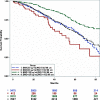Repeated measures of body mass index and waist circumference in the assessment of mortality risk in patients with myocardial infarction
- PMID: 30256695
- PMCID: PMC6450500
- DOI: 10.1080/03009734.2018.1494644
Repeated measures of body mass index and waist circumference in the assessment of mortality risk in patients with myocardial infarction
Abstract
Aims: Weight loss is recommended for myocardial infarction (MI) patients with overweight or obesity. It has, however, been suggested that obese patients have better prognosis than normal-weight patients have, but also that central obesity is harmful. The aim of this study was to examine associations between repeated measures of body mass index (BMI) and waist circumference (WC), and all-cause mortality.
Methods and results: A total of 14,224 MI patients aged <75 years in Sweden between the years 2004 and 2013 had measurements of risk factors at hospital discharge. The patients' BMI and WC were recorded in secondary prevention clinics two months and one year after hospital discharge. We collected mortality data up to 8.3 years after the last visit. There were 721 deaths. We used anthropometric measures at the two-month visit and the change from the two-month to the one-year visit. With adjustments for risk factors and the other anthropometric measure the hazard ratio (HR) per standard deviation in a Cox proportional hazard regression model for mortality was 0.64 (95% confidence interval [CI] 0.56-0.74) for BMI and 1.55 (95% CI 1.34-1.79) for WC, and 1.43 (95% CI 1.17-1.74) for a BMI decrease from month two to one year of more than 0.6 kg/m2. Low BMI and high WC were associated with the highest mortality.
Conclusion: High WC is harmful regardless of BMI in MI patients. Reduced BMI during the first year after MI is, however, associated with higher mortality, potentially being an indicator of deteriorated health.
Keywords: Body mass index; myocardial infarction; obesity paradox; repeated measurements; waist circumference.
Figures


References
-
- SWEDEHEART 2011Annual Report 2012.
-
- De Bacquer D, De Backer G, Cokkinos D, Keil U, Montaye M, Ostor E, et al. . Overweight and obesity in patients with established coronary heart disease: are we meeting the challenge? Eur Heart J. 2004;25:121–8. - PubMed
-
- Piepoli MF, Hoes AW, Agewall S, Albus C, Brotons C, Catapano AL, et al. . 2016 European Guidelines on cardiovascular disease prevention in clinical practice. Rev Esp Cardiol (Engl Ed). 2016;69:939. - PubMed
-
- Romero-Corral A, Montori VM, Somers VK, Korinek J, Thomas RJ, Allison TG, et al. . Association of bodyweight with total mortality and with cardiovascular events in coronary artery disease: a systematic review of cohort studies. Lancet. 2006;368:666–78. - PubMed
Publication types
MeSH terms
LinkOut - more resources
Full Text Sources
Other Literature Sources
Medical
